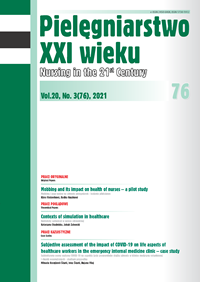Contexts of simulation in healthcare
DOI:
https://doi.org/10.2478/pielxxiw-2021-0024Keywords:
simulation, education, nursing, healthcareAbstract
CONTEXTS OF SIMULATION IN HEALTHCARE
Introduction. Simulation in the education of future nursing staff dates back to 1911. Technological progress over the years has resulted in the situation in which nowadays Medical Simulation Centres use top-class equipment, training is supported by standards, and students master their skills, not only the practical ones, but also those related to team communication or working under time pressure. In addition, virtual simulation is becoming more and more popular, which, in the current times of the coronavirus pandemic, allows for conducting classes.
Aim. To present the evolution and the importance of medical simulation in the training of nurses.
Method. Non-systematic review of the topic literature; the selection of documents (in Polish and English) for the years 2009-2021 consistent with the aim of the review.
Summary. Medical simulation centres are places which not only serve the purpose of developing future medical staff, but also constitute an ideal space for professional development of the already professionally active medical staff.
References
1. NLN Board of Governors. A Vision for Teaching with Simulation. NLN Vision Series. April, 2015. http://www.nln.org/docs/default-source/about/nln-vision-series-(position statements)/vision-statement-a-vision-for-teaching-with-simulation.pdf?sfvrsn=2.
2. Lioce L, Lopreiato J, Downing D, i wsp. Healthcare Simulation Dictionary – Second Edition. Rockville, MD: Agency for Healthcare Research and Quality. 2020; 44: 21.
3. Ryall T, Judd BK, Gordon CJ. Simulation-based assessments in health professional education: A systematic review. Journal of Multidisciplinary Healthcare. 2016, 9: 69-82.
4. Galloway SJ. Simulation Techniques to Bridge the Gap Between Novice and Competent Healthcare Professionals. The Online Journal of Issues in Nursing. 2009, 14(2,3).
5. Hopkins D. red. Framework for Action on Interprofessional Education and Collaborativ Practice (WHO/HRH/HPN/10.3) World Health Organisation. http://www.who.int/hrh/nursing_midwifery/en/.
6. INACSL Standards Committee. INACSL Standards of Best Practice: SimulationSM Simulation-enhanced interprofessional education (sim-IPE). Clinical Simulation in Nursing. 2016, 12: 34-38.
7. Chiniara G, Cole G, Brisbin K, et al. Simulation in healthcare: A taxonomy and a conceptual framework for instructional design and media selection. Medical Teacher. 2013; 35(8): 1380-1395.
8. Bogossian F, Cooper S, Kelly M, et al. The use of simulation as a learning approach to non technical skills awareness in final year student nurses. Clinical Simulation in Nursing. 2019; 11(3): 425-430.
9. Shepherd I, Burton T, A conceptual framework for simulation in healthcare education – The need. Nurse Education Today. 2019; 76(1): 21-25.
10. Brien R, Mould J. Interprofessional education. [w:] Riley RH, red. Manual of Simulation of healthcare. United Kingdom: Oxford University Press; 2016, s. 141-160.
11. Team STEPPS. https://www.ahrq.gov/teamstepps/index.html (dostęp 28.12.2020).
12. Benner P. From novice to expert. American Journal of Nursing.1982; 82(3): 402-407.https://www.medicalcenter.virginia.edu/therapy-services/3 - Benner - Novice to Expert-1.pdf.
13. Jeffries PR, Rizzolo MA. Designing and implementing models for the innovative use of simulation to teach nursing care of ill adults and children : a national, multisite, multi-method study. National League for Nursing; 2016, s. 1-17.
14. Jeffries PR, Rogers KJ. Theoretical framework for simulation design. [w:] Jeffries P, red. Simulation in nursing education: From conceptualization to evaluation 2nd edition. New York: National League for Nursing; 2012, s. 25-42.
15. Cowperthwait A. NLN/Jeffries Simulation Framework for Simulated Participant Methodology. Clinical Simulation in Nursing. 2020; 42: 12-21.
16. Regulation of the Minister of Science and Higher Education of May 9, 2012 on education standards for the fields of study: medicine, dentistry and dentistry, pharmacy, nursing and obstetrics. Journal of Laws. 2012, poz. 631.
17. Regulation of the Minister of Science and Higher Education of 26 July 2019 on training standards for the profession of a doctor, dentist, pharmacist, nurse, midwife, laboratory diagnostician, physiotherapist and paramedic. Journal of Laws. 2019; poz 1573.
18. Resolution No. 103/IV/2017 of June 22, 20217 on the implementation of classes in Medical Simulation Centers - multi and monoprofile in the field of nursing and obstetrics of the National Accreditation Council of Schools of Nurses and Midwives in Poland https://www.gov.pl/web/zdrowie/krajowa-rada-akredytacyjna-szkol-pielegniarek-i-poloznych-kraszpip-pdf (dostęp 28.12.2020)
19. Motola I, Devine LA, Chung HS, i wsp. Simulation in healthcare education: A best evidence practical guide. Medical Teacher AMEE Guide No. 82. 2013; 35(10): 42-159.
20. Padilha JM, Machado PP, Ribeiro AL, i wsp. Clinical Virtual Simulation in Nursing Education. Clinical Simulation in Nursing. 2018; 15: 13-18.
21. Sperl-Hillen J, O’Connor PJ, Ekstrom HL, i wsp. Educating resident physicians using virtual case-based simulation improves diabetes management: a randomized controlled trial. Academic medicine: journal of the Association of American Medical Colleges. 2014; 89(12): 1664-1673.
22. Tschannen D, Aebersold M, McLaughlin E, i wsp. Use of virtual simulations for improving knowledge transfer among baccalaureate nursing students. Journal of Nursing Education and Practice. 2012; 2(3): 15-24.
23. Using Distance Simulation to Supplement Clinical Hours. https://oxfordmedicalsimulation.com/tag/virtual-reality-simulation (dostęp 5.01.2021).
24. the procedure for putting on the coveralls. Warsaw Medical University. https://www.youtube.com/watch?v=qcu7UKJi0OA (dostęp 9.01.2021).
25. MOPR and DPS employees trained how to fight the coronavirus. https://radioszczecin.pl/1,408545,pracownicy-mopr-u-i-dps-ow-szkolili-sie-jak-walc (dostęp 9.01.2021).
26. Medical Simulation Center. Apparatus treatment of respiratory failure. http://www.csm.umed.wroc.pl/2020/12/07/aparaturowe-leczenie-niewydolnosci-oddechowej/ (dostęp 9.01.2021).
27. COVID training. Medical University of Lodz. https://umed.pl/szkolenia-covid-2 (dostęp 9.01.2021).
28. Coelho P. The Pilgrimage. HarperCollins Publishers; 2005.
Downloads
Published
Issue
Section
License
Copyright (c) 2021 Authors

This work is licensed under a Creative Commons Attribution-NonCommercial-NoDerivatives 4.0 International License.




